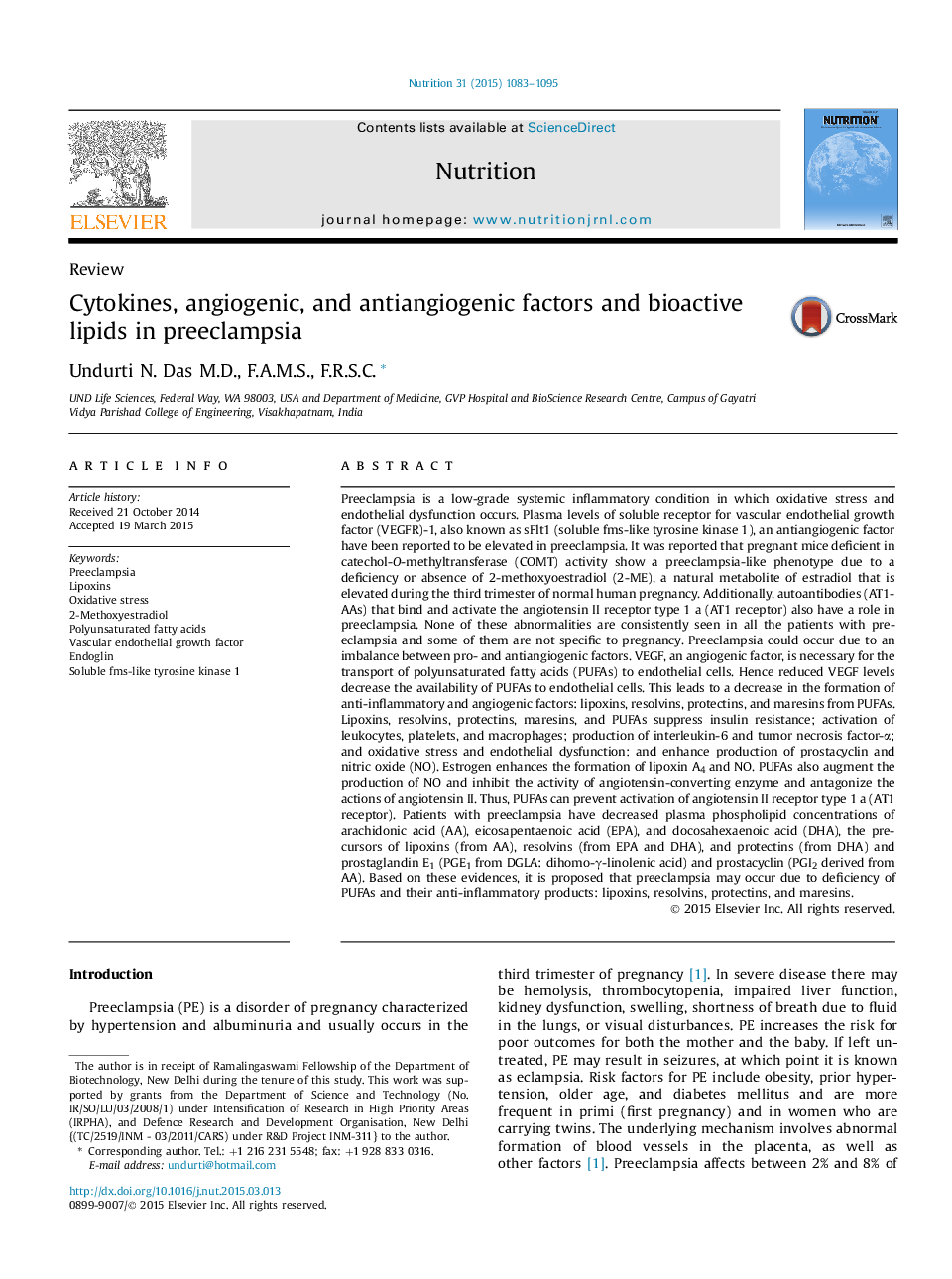| کد مقاله | کد نشریه | سال انتشار | مقاله انگلیسی | نسخه تمام متن |
|---|---|---|---|---|
| 6088991 | 1208531 | 2015 | 13 صفحه PDF | دانلود رایگان |
- It is suggested that preeclampsia is a low-grade systemic inflammatory condition.
- An imbalance between pro- and antiangiogenic substances leads to the onset of preeclampsia.
- Plasma and tissue levels of polyunsaturated fatty acids are reduced in preeclampsia.
- Deficiencies of lipoxins, resolvins, protectins, maresins, and nitrolipids may lead to the development of preeclampsia.
- Vascular endothelial growth factor transports polyunsaturated fatty acids to endothelial cells.
- Vascular endothelial growth factor deficiency in preeclampsia leads to decreased formation of lipoxins, resolvins, protectins, maresins, and nitrolipids.
- Lipoxins, resolvins, protectins, maresins, and nitrolipids may be of benefit in preeclampsia.
Preeclampsia is a low-grade systemic inflammatory condition in which oxidative stress and endothelial dysfunction occurs. Plasma levels of soluble receptor for vascular endothelial growth factor (VEGFR)-1, also known as sFlt1 (soluble fms-like tyrosine kinase 1), an antiangiogenic factor have been reported to be elevated in preeclampsia. It was reported that pregnant mice deficient in catechol-O-methyltransferase (COMT) activity show a preeclampsia-like phenotype due to a deficiency or absence of 2-methoxyoestradiol (2-ME), a natural metabolite of estradiol that is elevated during the third trimester of normal human pregnancy. Additionally, autoantibodies (AT1-AAs) that bind and activate the angiotensin II receptor type 1 a (AT1 receptor) also have a role in preeclampsia. None of these abnormalities are consistently seen in all the patients with preeclampsia and some of them are not specific to pregnancy. Preeclampsia could occur due to an imbalance between pro- and antiangiogenic factors. VEGF, an angiogenic factor, is necessary for the transport of polyunsaturated fatty acids (PUFAs) to endothelial cells. Hence reduced VEGF levels decrease the availability of PUFAs to endothelial cells. This leads to a decrease in the formation of anti-inflammatory and angiogenic factors: lipoxins, resolvins, protectins, and maresins from PUFAs. Lipoxins, resolvins, protectins, maresins, and PUFAs suppress insulin resistance; activation of leukocytes, platelets, and macrophages; production of interleukin-6 and tumor necrosis factor-α; and oxidative stress and endothelial dysfunction; and enhance production of prostacyclin and nitric oxide (NO). Estrogen enhances the formation of lipoxin A4 and NO. PUFAs also augment the production of NO and inhibit the activity of angiotensin-converting enzyme and antagonize the actions of angiotensin II. Thus, PUFAs can prevent activation of angiotensin II receptor type 1 a (AT1 receptor). Patients with preeclampsia have decreased plasma phospholipid concentrations of arachidonic acid (AA), eicosapentaenoic acid (EPA), and docosahexaenoic acid (DHA), the precursors of lipoxins (from AA), resolvins (from EPA and DHA), and protectins (from DHA) and prostaglandin E1 (PGE1 from DGLA: dihomo-γ-linolenic acid) and prostacyclin (PGI2 derived from AA). Based on these evidences, it is proposed that preeclampsia may occur due to deficiency of PUFAs and their anti-inflammatory products: lipoxins, resolvins, protectins, and maresins.
Journal: Nutrition - Volume 31, Issue 9, September 2015, Pages 1083-1095
